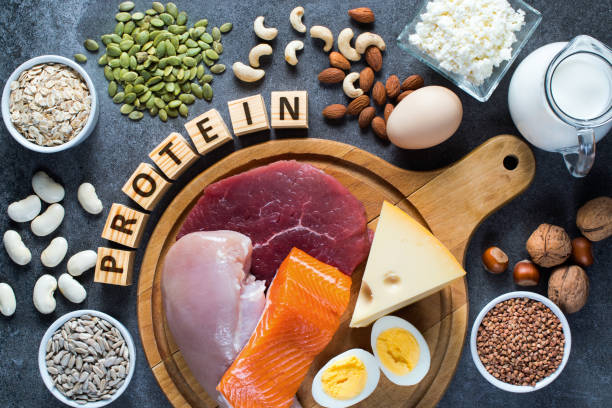Protein are essential macro molecules found in every living organism, playing a fundamental role in various biological processes. Composed of amino acids, they serve as the building blocks for cells, tissues, and organs, contributing to the structure, function, and regulation of the human body.
Proteins are synthesized through a process known as protein synthesis or translation. This occurs in ribosomes, where messenger RNA (mRNA) serves as a template for assembling amino acids in the correct sequence. Transfer RNA (tRNA) molecules bring the appropriate amino acids to the ribosome, facilitating their incorporation into the growing polypeptide chain.
Genes, which are segments of DNA, contain the information required for protein synthesis. Transcription involves the conversion of DNA into mRNA, which then guides protein synthesis. Mutations in genes can lead to altered protein sequences, potentially affecting their structure and function, and contributing to various genetic disorders.
Proteins can also undergo post-translational modifications, where chemical groups are added to the amino acid chains after synthesis. These modifications can impact protein stability, localization, and activity. Phosphorylation, glycosylation, and acetylation are examples of such modifications that regulate protein function.
Types of proteins:-
Proteins can be categorized into several types based on their structure, function, and properties. Here are some of the main types of proteins:
Enzymes: Enzymes are catalysts that accelerate biochemical reactions by lowering the activation energy required for the reactions to occur. Examples include amylase (breaks down carbohydrates), lipase (breaks down fats), and DNA polymerase (involved in DNA replication).
Structural Proteins: These proteins provide support and shape to cells and tissues. Examples include collagen (found in connective tissues), keratin (found in hair and nails), and tubulin (a component of microtubules in the cytoskeleton).
Transport Proteins: These proteins facilitate the movement of molecules across cell membranes or within the bloodstream. Hemoglobin, for instance, transports oxygen in red blood cells, while ion channels transport ions across cell membranes.
Hormones: Hormones are signaling molecules that regulate various physiological processes. Insulin, for example, regulates blood sugar levels, while adrenaline prepares the body for a “fight or flight” response.
Antibodies: Also known as immunoglobulins, antibodies are part of the immune system and help identify and neutralize foreign invaders such as bacteria and viruses.
Receptor Proteins: These proteins are located on cell membranes and are involved in receiving and transmitting signals from the external environment. G protein-coupled receptors (GPCRs) and receptor tyrosine kinases (RTKs) are examples.
Storage Proteins: These proteins store essential molecules for later use. Ferritin stores iron, and casein stores nutrients in milk.
Contractile Proteins: Contractile proteins are responsible for muscle contraction and movement. Actin and myosin are key contractile proteins found in muscle cells.
Chaperone Proteins: Chaperones assist in the proper folding of other proteins and prevent misfolding or aggregation. They ensure that proteins achieve their functional three-dimensional structures.
Cell Adhesion Proteins: These proteins mediate cell-cell interactions and help cells stick together in tissues. Cadherins and integrins are examples of cell adhesion proteins.
Toxic Proteins: Some proteins, such as venom toxins, are produced by organisms to harm or immobilize prey or defend against predators.
Signaling Proteins: These proteins are involved in transmitting signals within cells. Protein kinases, for instance, add phosphate groups to other proteins, altering their function and activity.
Nucleoproteins: These proteins are associated with nucleic acids (DNA and RNA). Histones, for example, help package DNA into chromatin in eukaryotic cells.
Globular Proteins: These proteins have a compact, rounded shape and often have enzymatic or signaling functions. Hemoglobin and myoglobin are examples.
Fibrous Proteins: These proteins have elongated, fiber-like structures and are often involved in providing structural support. Collagen and keratin are fibrous proteins.
Sources of proteins:-
Proteins are essential nutrients that can be obtained from a variety of dietary sources. Here are some common sources of proteins:
Animal Sources:
Meat: Beef, pork, lamb, and poultry (chicken, turkey) are rich sources of complete proteins.
Fish and Seafood: Fish such as salmon, tuna, and cod, as well as shellfish like shrimp and crab, provide high-quality protein and essential omega-3 fatty acids.
Eggs: Eggs are a complete protein source and also contain essential vitamins and minerals.
Dairy Products: Milk, yogurt, cheese, and other dairy products contain protein along with calcium and other nutrients.
Plant Sources:
Legumes: Lentils, chickpeas, beans (black beans, kidney beans, etc.), and peas are excellent sources of plant-based protein, fiber, and various vitamins and minerals.
Soy Products: Tofu, tempeh, and edamame are complete sources of protein and are commonly used in vegetarian and vegan diets.
Nuts and Seeds: Almonds, walnuts, peanuts, chia seeds, and flaxseeds provide protein, healthy fats, and other nutrients.
Whole Grains: Quinoa, brown rice, oats, and whole wheat products contribute to protein intake and offer dietary fiber.
Vegetables: Some vegetables like broccoli, spinach, and Brussels sprouts contain protein, although they are generally lower in protein compared to other sources.
Plant-Based Protein Products:
Plant-Based Meat Alternatives:These products, made from sources like soy, peas, or other plant proteins, mimic the taste and texture of meat.
Protein Powders: Protein powders derived from sources like whey, casein, soy, pea, rice, or hemp can be added to shakes, smoothies, and recipes to increase protein intake.
Combining Sources for Complete Proteins:
Some plant sources are not complete proteins on their own but can be combined to create complete protein sources. For example, combining beans and rice or whole wheat bread with peanut butter can provide a balanced amino acid profile.
In conclusion, proteins are multifaceted biomolecules with diverse functions critical for life. Their intricate structures and intricate roles make them fascinating subjects of study in the fields of biochemistry, molecular biology, and medicine. Understanding protein structure and function is pivotal for unraveling the mysteries of life’s complexities and developing therapies for various diseases.

